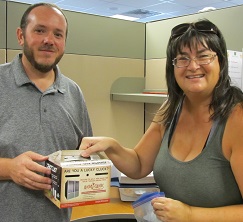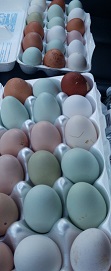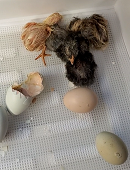By Yvonne Florian and Christine Kelly-Begazo
Our 4-H embryo development display came to live at my house. It was meant as a 4-H demonstration for the Indian River County Firefighters’ Fair which would run from March 13th through the 22nd. But our fair event was restructured at the very last hour due to COVID-19 preventive measures.
The afternoon of Friday the 13th the Fair board decided to close all public midway exhibits and rides. After careful deliberation, the private nonprofit IRC Youth Livestock & Horticulture board decided to continue the scheduled Show and Auction event (with many 4-H youth participating) under the Fair AG Barn, but restructured as a semi-private event following social distancing guidelines. This was a mixed blessing as most of you know there’s a lot of work and late nights which go into County Fair 4-H events, exhilarating yet exhausting! The work of setting up the fair had already been completed by staff and volunteers. Now Extension staff quickly switched gears and began thinking about how to work remotely from home, provide programs virtually and how to keep volunteer groups such as Master Gardeners and 4-H clubs active using social distancing guidelines. Thus, the chicks, just one to three days old, came home with me, the program assistant.
What is Embryology?

Embryology is the study of pre-born life. Our display was to use live chicks, incubated and hatched right there in the indoor fair exhibit hall, and some kept at the Extension 4-H office. The resulting chicks were then to be enrolled in our 4-H “Rent-A-Chick” program.
How Do You Rent a Chick?
This program is geared toward wanna-be chicken owners who are unsure if they want to commit to adopting birds full-time. For a small fee, renters get to take home chicks, feed, feed dispenser, water tank, and a small “chicken house” brooder box. This is so they can experience caring for their chicks to see if they might want to keep chickens permanently.

The Incubation Period
Three dozen fertilized eggs had been generously donated by local poultry enthusiast, D. Elrod in mid-February. At the IRC Extension 4-H office, the incubator was set up and eighteen of the eggs were installed to start the development cycle of growing chicks. The rest were to be started at intervals so fair-goers could see hatching in progress as well as cute, fluffy chicks. A week into that first incubation period, Extension office staff began hearing the possibilities of rescheduling all public meetings, county buildings closing to walk-in traffic or being closed altogether. We worried a bit about all the events we had planned for the rest of the season through to end of summer.

Brand New Chicks
There was excitement about incubating eggs in the office. I had not witnessed the process since I was a small child. And I was curious about how it was done, how long it takes, all those details to which I paid little attention as a child. By showing and explaining each phase, Darren Cole, our 4-H agent got us past the scary prospect of incubating & hatching eggs. And those little peeps are just so CUTE. But they don’t stay little for long.

In the past, the thought of hatching eggs made me anxious. There are just so many ways nature can take different paths. Even with the automated incubator regulating temperature, humidity, and the turning of the eggs, not all of the eggs hatched.
I’d wanted to renew my own aged backyard flock and had already volunteered to adopt a few of the new chicks. I requested “colored” eggs: blue, green, and copper. And of those eighteen eggs which were originally set into the 4-H office incubator, only thirteen hatched. Sadly, not one of the copper eggs made it.

County Code and Chickens in a Residential Neighborhood
Our county has an ordinance or code about keeping backyard chickens: As long as your neighborhood or HOA (Home Owners Association) does not forbid them you may keep up to five chickens in your backyard. According to IRC Code, No roosters are allowed in residential areas of Indian River County.
How I Got My First Flock

For almost fifteen years of my adult life I knew I wanted some backyard hens for fresh eggs. But I’m a suburban girl, we live in an older development. Our neighbors have pools and pretty landscaping. I had never raised livestock before. But people keep flocks in cities, in garages, and on rooftops, right? So I mentioned my desire for a flock to my husband many times, trying to plant the seed of the idea into his mind over those fifteen years. But he always gave an adamant “NO!” declaration.
Eventually, a friend of his gifted us with a handmade pallet-coop, two half-grown pullets and two older laying hens. At that point in my life, I had never even touched a live chicken. My poultry raising knowledge had been limited to what books I could find at our local public library (two books) and magazine articles (thank you, Martha Stewart!). I now can peruse the collection of poultry rearing books that Darren, the 4-H Agent has in his library.
Count the Cost

This was my first flock and it hadn’t cost us anything- YET. Have you ever done those math story problems? Here’s one for you. The two older birds gave us an egg each and about once a week until they got used to our place. The new pullets laid no eggs for over EIGHT MONTHS! A 50 lb. bag of feed cost $15 and lasted two weeks. Here’s where the math story problem comes in. How much did those first four eggs cost? $15 for FOUR eggs. So a dozen would cost us $45! Depending upon the laying ability of your chickens, backyard egg production might not necessarily save you money, but raising your own chickens is fun, educational and the eggs taste great!
If you’d like to have friendly birds for your children, you must handle them every day from the day they hatch. Even then, there will still be a few birds too skittish to handle and hold. They each will have their own personality and a pecking order. My two most friendly birds were once a child’s 4-H fair project. They love my 4-year-old grandson.
What do chickens need?

Chickens are relatively easy-care animals. However, they will need a bit more than just food, water and shelter. Here are the basics:
- Feed– Chickens are omnivorous. Even if your laying hens are going to free-range during the day, they will need feed with added calcium for egg production. Also they will scratch up the ground looking for grubs and bugs. If you want to keep them out of your edibles and flower beds, fence them in. Chickens love insects. Also green onions, peppers, and tomato leaves. Though these last three will NOT harm them, they will make their eggs taste bitter. Chickens are omnivorous. Let them loose on a mulch or compost pile and they will feast all day and spread your compost for you. Some other free chicken foods are: crushed acorns, cold watermelon rind, kitchen scraps, and June bugs from the screen door.

G. C. Gregory, drinks water out of a hose in his yard in demonstrating the value of water quality. - Water– Chickens need fresh water at all times, even in their coop at night. Water dispensers should not be sitting on the floor or ground since scratching activities of the birds will contaminate the water.
- Shelter– A chicken coop should be made easy to clean! It should have solid walls, roof, and floor, and a door which can be securely closed each night after roosting. Chickens will automatically go in it to roost at dusk.
- Roost– Inside the coop, there should be a roost bar placed up off the coop floor and away from the nest boxes. Birds have no sphincter control so half their manure will be expelled at night while they are in their coop roosting. Wood shavings will control odors.
- Nest boxes– It is recommended that you have one nest box for every 3 or 4 birds. Though my birds always all use the same nest box no matter how many others I provide of identical materials, dimensions & content.
- A Pal. Chickens are social animals, they live in flocks and will NEED a buddy.
- The Run– Even if your chickens are going to be “free-range” you may want to have a run area, just in case. I found out the hard way that “Chickens eat everything & everything likes to eat chickens”. The run should be completely encased in chicken-wire- top, doors, and sides. And the sides should be buried into the ground for at least a foot at the bottom all the way around.
The Predators
Chickens have many predators. And each leaves its own specific mark which will tell you what got the bird – after the fact. Prevention is key. But free-range hens are so much happier and you cannot chicken-wire your whole yard. The three main predators I’ve encountered in my Florida yard are:
- Neighborhood dogs– pet dogs love to chase fluffy, squeaky, running things. They think chickens are toys. They will kill any birds they can catch and may or may not eat one.

Bobcat, Lynx rufus - Bobcats– a female bobcat with a litter will hunt in broad daylight even with you nearby. They are quick as lightening and leave behind a pile of feathers and nothing else.
- Raccoons– almost always raccoons hunt at night. If your coop appears to be broken-into and birds vanish at night, it is most likely a raccoon. They are very intelligent, even figuring out simple latches, bungee cords, and wire loops. Occasionally, young ‘coons newly kicked out of the nest will come by daylight to steal eggs. But those don’t like to tangle with raucous birds during the day. Adult raccoons may kill every bird in a coop or just try to make off with one. They will leave some feathers and maybe the headless body.

Great Horned Owl in a slash pine, photo by Andy Morffew
Of course there are other marauders which will try to pick off your flock: foxes, coyote, owls, hawks, snakes, feral cats, weasels, panthers, and even bears (yes, we still have a few in Florida). But I’ve only experienced the three listed above in the four years I’ve kept chickens in suburban Indian River County.
Resources
To learn more about raising chickens, the University of Florida’s EDIS (Electronic Data Information Source) has a great publication titled, “Raising Backyard Chickens for Eggs” On their website: https://edis.ifas.ufl.edu/an239.
Our Agriculture Agent, Christine Kelly-Begazo, offers an annual class on backyard chickens and can answer your poultry questions. She can be contacted at ckellybe@ufl.edu or by calling (772) 226-4316.
 0
0



